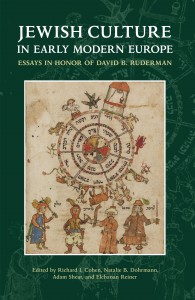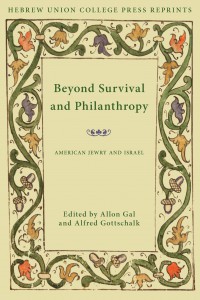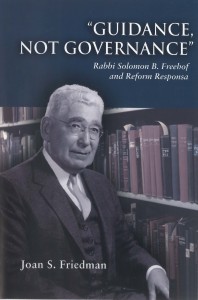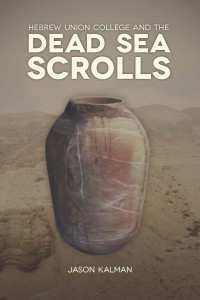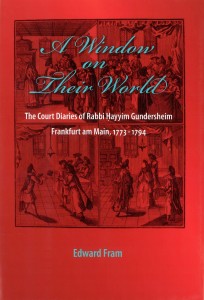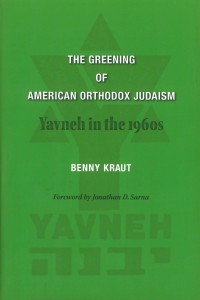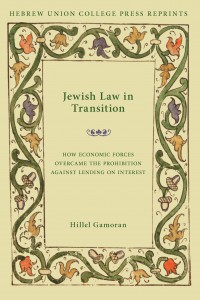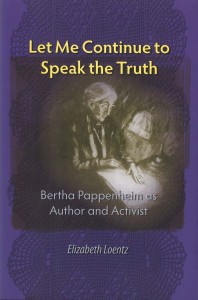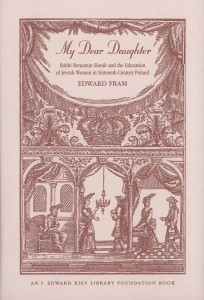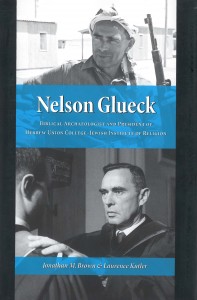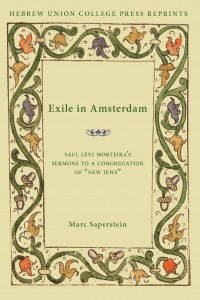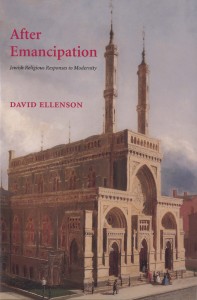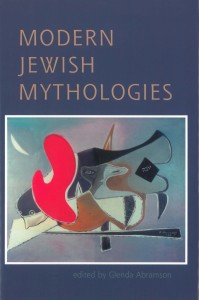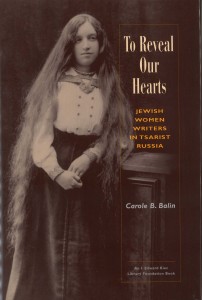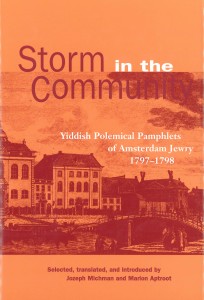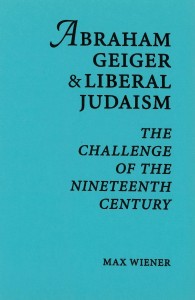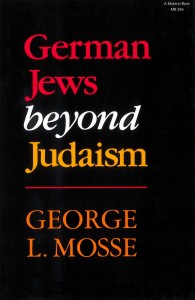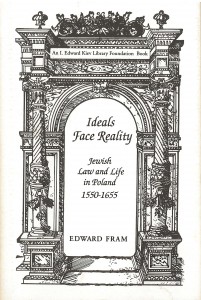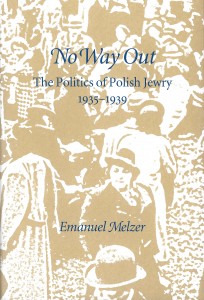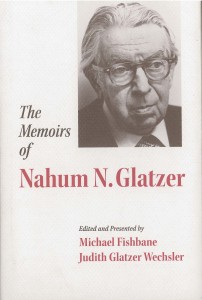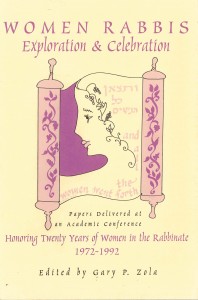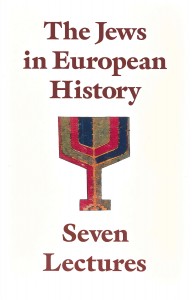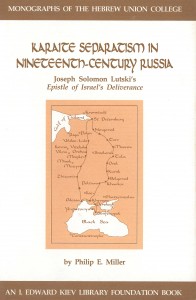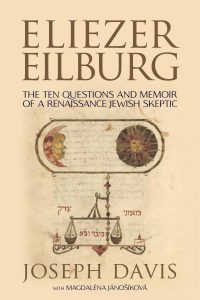
Eliezer Eilburg: The Questions & Memoir of a Renaissance Jew
Joseph Davis
Before the Enlightenment, before Spinoza had rejected traditional beliefs about the Bible, came the humanistic skeptics of the Renaissance. Alongside oft-cited Christian thinkers, Eliezer Eilburg now takes his rightful place. Comparable in view to Christopher Marlowe or Noël Journet, Eilburg perhaps uniquely represents the possibilities of Jewish skepticism in his day.
The Jews in Christian Europe: A Source Book, 315-1791
Jacob Rader Marcus and Marc Saperstein
First published in 1938, Jacob Rader Marcus’s The Jews in The Medieval World has remained an indispensable resource for its comprehensive view of Jewish historical experience from late antiquity through the early modern period, viewed through primary source documents in English translation. In this new work, Marc Saperstein has recast the volume’s focus, now fully centered on Christian Europe, updated the work’s organizational format, and added seventy-two new annotated sources. In his compelling introduction, Saperstein supplies a modern and thought-provoking discussion of the changing values that influence our understanding of history, analyzing issues surrounding periodization, organization, and inclusion.
Jewish Culture in Early Modern Europe: Essays in Honor of David B. Ruderman
Richard I. Cohen, Natalie B. Dohrmann, Adam Shear, and Elchanan Reiner, eds.
David B. Ruderman’s groundbreaking studies of Jewish intellectuals as they engaged with Renaissance humanism, the Scientific Revolution, and the Enlightenment have set the agenda for a distinctive historiographical approach to Jewish culture in early modern Europe, from 1500 to 1800. Thirty-one leading scholars celebrate Ruderman’s stellar career in essays that bring new insight into Jewish culture as it is intertwined in Jewish, European, Ottoman, and American history. The volume presents probing historical snapshots that advance, refine, and challenge how we understand the early modern period and spark further inquiry.
Beyond Survival and Philanthropy: American Jewry and Israel
Edited by Allon Gal and Alfred Gottschalk
Sometimes agreeing, sometimes disagreeing, but always expanding upon these presentations, authors of the response essays in the volume reflect and underscore the values that precipitated this discussion: recognition of the unity of the Jewish people and of the continuing to share diverse views and opinions in order to formulate and address the crucial and sometimes radical choices that confront American Jewry and Israel. Beyond Survival and Philanthropy is a collection of answers to this complex question offered by thirty-one leading Israeli and American scholars, educators, journalists, and communal leaders.
Sisterhood: A Centennial History of Women of Reform Judaism
edited by Carole B. Balin, Dana Herman, Jonathan D. Sarna, and Gary P. Zola
Women of Reform Judaism marks its centennial anniversary with this collection of new scholarly essays which looks back at its history in order to understand how the hopes and dreams of its founders have come to fruition. Essays consider Women of Reform Judaism’s religious activities, contributions to American Jewish culture, programs and projects, and role as an agent of change. Sisterhood fills a void in the study of women’s philanthropic organizations, as no sustained attention has heretofore been paid to the contributions of women to the American synagogue.
Guidance, Not Governance: Rabbi Solomon B. Freehof and Reform Responsa
Joan S. Friedman
Solomon B. Freehof (1892-1990) called for Reform Judaism to turn to halakhah, not in order to adhere to codified law, but to offer “guidance, not governance” through the writing of responsa. Friedman analyzes Freehof’s responsa on a select number of crucial issues that illustrate the evolution of American Reform Judaism and discusses the deeper issues with which the movement struggled, and continues to struggle, in its attempt to meet the ever-changing challenges of the present while preserving both individual autonomy and faithfulness to the Jewish tradition.
Hebrew Union College and the Dead Sea Scrolls
Jason Kalman
The bare outline of the story of the discovery of the Dead Sea Scrolls is well known, but the precise details are sometimes completely forgotten or misconstrued. The recovery of this history in all its complexity is vital for understanding how and why scholarly work on the Scrolls developed as it did over the six decades during which the texts were slowly published. Jason Kalman recovers the fascinating story of Hebrew Union College’s involvement with the Dead Sea Scrolls from their discovery in 1948 until the early 1990s when they were first made accessible to all scholars and to the public.
A Window on Their World: The Court Diaries of Rabbi Hayyim Gundersheim, Frankfurt am Main, 1773-1794
Edward Fram
From a manuscript that was lost for more than half a century comes new information about one of the greatest Jewish communities of all time. The court diaries of Rabbi Hayyim Gundersheim (d. 1795), a member of the rabbinic court of late eighteenth-century Frankfurt, sheds light on daily life in the Judengasse (“Jewish lane”). Edward Fram’s transcription gives readers access to this source, along with pertinent documents from Frankfurt’s community record book, important for the study of European Jewry on the eve of the Enlightenment.
The Greening of American Orthodox Judaism: Yavneh in the 1960s
Benny Kraut
Yavneh serves as an illuminating historical marker by which to probe the evolution of American Orthodox Judaism from the 1960s to the early 1980s, when it ceased to exist. Yavneh and its members and supporters contributed significantly to the revitalization of Orthodoxy but also experienced the same tensions felt across the movement during this period. Benny Kraut’s historical account brings this singular organization to public consciousness and offers a revealing glimpse of American Orthodox Judaism at a critical juncture in its recent growth.
Remnant Stones: The Jewish Cemeteries of Suriname: Essays
Aviva Ben-Ur and Rachel Frankel
In the 1660s, Jews of Iberian ancestry established an agrarian settlement in the midst of the Surinamese tropics. The heart of this community—Jodensavanne, or Jews’ Savannah—became an autonomous village with its own Jewish institutions. This volume of essays offers a historical and cultural overview of Suriname’s Jewish community, with special emphasis on its synagogues and the Jewish and Creole cemeteries. It complements the first volume, Remnant Stones: The Jewish Cemeteries of Suriname: Epitaphs, which presents transcriptions, English translations, annotations, and selected photographs of nearly 1,700 gravestones, accompanied by scaled plans of the cemeteries.
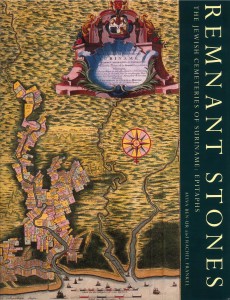 Remnant Stones: The Jewish Cemeteries of Suriname: Epitaphs
Remnant Stones: The Jewish Cemeteries of Suriname: Epitaphs
Aviva Ben-Ur and Rachel Frankel
In the 1660s, Jews of Iberian ancestry, many of them fleeing Inquisitorial persecution, established an agrarian settlement in the midst of the Surinamese tropics. The heart of this community—Jodensavanne, or Jews’ Savannah—became an autonomous village with its own Jewish institutions. This volume presents transcriptions and English translations of nearly 1,700 epitaphs, carved in Portugese, Hebrew, Spanish, Dutch, Aramaic, and French. A fold-out scaled plan of each of the cemeteries shows stone orientation, locations, and adjacencies. A companion volume, Remnant Stones: The Jewish Cemeteries of Suriname: Essays, traces the history of Surinamese Jewry and presents a social, cultural, and architectural analysis of Suriname’s fascinating Jewish community.
Jewish Law in Transition: How Economic Forces Overcame the Prohibition against Lending on Interest
Hillel Gamoran
The prohibition against lending on interest (Exodus 22:24) was intended to prevent the wealthy from exploiting the unfortunate. In the course of time, it was seen to have consequences that militated against the economic welfare of Jewish society as a whole. As a result, Jewish law (halakhah) has over the centuries relaxed the biblical injunction, allowing interest charges despite the biblical prohibition. Hillel Gamoran seeks to explain how rabbis, from the Tannaim until the present day, have struggled with the law and with one another and used inventive interpretation to create the legal fictions necessary for business life to flourish.
Let Me Continue to Speak the Truth: Bertha Pappenheim as Author and Activist
Elizabeth Loentz
In 1953, Freud biographer Ernest Jones revealed that the famous hysteric Anna O. was really Bertha Pappenheim (1859-1936), the prolific author, German-Jewish feminist, pioneering social worker, and activist. Loentz directs attention away from the young woman who arguably invented the talking cure and back to Pappenheim and her post-Anna O. achievements, especially her writings, which reveal one of the most versatile, productive, influential, and controversial Jewish thinkers and leaders of her time.
My Dear Daughter: Rabbi Benjamin Slonik and the Education of Jewish Women in Sixteenth-Century Poland
Edward Fram
To teach observance of the three women’s commandments—the laws of challah, Sabbath candles, and menstrual separation—in a systematic and impersonal manner, Rabbi Benjamin Slonik (ca. 1550-1620) harnessed the relatively new technology of printing and published a how-to pamphlet for women in the Yiddish vernacular. Fram transcribes, translates, and analyzes Slonik’s pamphlet and presents a treasure trove of information about the place and roles of women in late sixteenth-century Polish-Jewish society.
Nelson Glueck: Biblical Archaeologist and President of the Hebrew Union College-Jewish Institute of Religion
Jonathan M. Brown and Laurence Kutler
Nelson Glueck, affectionately called Ha-Professor (“The Professor”), was born in 1900 to a struggling immigrant Jewish family in Cincinnati. By 1950, he had become an archaeologist, a personal friend to many members of the political and intellectual scene in the nascent state of Israel, and president of Hebrew Union College. He instilled in students and readers alike a deep love for the ancient Land of Israel and made lasting contributions to the growth and future of Reform Judaism.
Exile in Amsterdam: Saul Levi Morteira’s Sermons to a Congregation of “New Jews”
Marc Saperstein
Exile in Amsterdam is based on a rich, extensive, and previously untapped source for one of the most important Jewish communities in early modern Europe: the sermons of Saul Levi Morteira (ca. 1596-1660), leading rabbi of Amsterdam and a master of Jewish homiletical art. After years of painstaking study from microfilms and three trips to Budapest to consult the actual manuscripts, Marc Saperstein has written the first comprehensive analysis of the historical significance of these texts, some of which were heard by the young Spinoza, and offers annotated English translations of eight examples.
After emancipation: Jewish Religious responses to modernity
David Ellenson
David Ellenson prefaces this fascinating collection of twenty-three essays with a remarkably candid account of his intellectual journey from boyhood in Virginia to the scholarly immersions in the history, thought, and literature of the Jewish people that have informed his research interests in a long and distinguished academic career. Ellenson has been particularly intrigued by the attempts of religious leaders in all denominations of Judaism, from Liberal to Neo-Orthodox, to redefine and reconceptualize themselves and their traditions in the modern period as both the Jewish community and individual Jews entered radically new realms of possibility and change.
Modern Jewish Mythologies
edited by Glenda Abramson
Based on the Mason Lectures delivered at the Oxford Centre for Hebrew and Jewish Studies in the winter of 1995, the ten essays in this volume demonstrate the function and dynamic effect Jewish mythologies in social, political, and psychological life. Essays treat topics including the Golem, the male superhero in Zionist myth, feminist treatments of Sarah, the role of the chevrah kaddisha, Kafka’s animal fables, and the role of myth in Jewish remembrance.
To Reveal Our Hearts: Jewish Women Writers in Tsarist Russia
Carole B. Balin
Carole Balin introduces us to dozens of Jewish women writers from late nineteenth- and early twentieth- century Tsarist Russia, focusing on five who were among the most prolific. Their extant literary remains include not only fiction, poetry, drama, translations, and essays, but also memoirs, autobiographies, diaries, and letters. The life-like and touching portraits that emerge of these talented writers allow us a penetrating view of Jewish women within their Russian-Jewish milieu that is far more nuanced than the images of balabuste (housewife) and revolutionary currently held in collective Jewish memory.
Storm in the Community: Yiddish Polemical Pamphlets of Amsterdam Jewry, 1797-1798
selected, translated, and introduced by Joseph Michman and Marion Aptroot
Inspired by the expanded freedom of the press and the satirical and often vulgar Spectatorial writings which were popular at the time, a small but energetic group of enlightened Jews in Amsterdam decided to publish a series of Yiddish polemical pamphlets (Diskursn) as an informative and propagandistic vehicle through which they could anonymously persuade the Jews of Amsterdam to choose the party of progress and enlightenment. This first-ever bilingual edition helps the reader understand and appreciate these colorful Dutch Jews and their often impassioned arguments.
Abraham Geiger & Liberal Judaism: The Challenge of the Nineteenth Century
Max Wiener
Abraham Geiger gave the Reform Movement in Judaism its intellectual stature and theoretical justification. The late Dr. Max Wiener here offers a sympathetic and balanced biographical introduction to Geiger, followed by English translations of select letters and excerpts from Geiger’s works, as well as sermons and articles written by Geiger. This volume will be of interest to anyone who seeks to understand the intellectual roots of liberal Judaism.
German Jews Beyond Judaism
George L. Mosse
Jews were emancipated at a time when high culture was becoming an integral part of German citizenship. German Jews felt a powerful urge to integrate, to find their Jewish substance in German culture and craft an identity as both Germans and Jews. In this volume, based on the 1983 Efroymson Memorial Lectures given at Hebrew Union College-Jewish Institute of Religion in Cincinnati, George Mosse traces their pursuit of Bildung and German Enlightenment ideals and their efforts to influence German society even at a time when this led to intellectual isolation. Yet out of this German-Jewish dialogue, what had once been part of German culture became a central Jewish heritage.
Ideals Face Reality: Jewish Law and Life in Poland, 1550-1655
Edward Fram
Jewish life in early modern Poland was characterized by an adherence to Jewish law (halakhah) that Polish Jewry had inherited from medieval Franco-German Jewry, and almost all aspects of Jewish activity fell within its purview. Jewish law remained constant throughout the ages in some areas, but in others rabbis were forced to reinterpret it in light of the complexities of contemporary life. Edward Fram shows how the Polish community, at times consciously and at times unconsciously, transformed some of its traditional values until they may have been unrecognizable to Jews from an earlier age.
No Way Out: The Politics of Polish Jewry, 1935-1939
Emanuel Melzer
Emanuel Melzer demonstrates that the politics of Polish Jewry concerning questions of policy and the tenacious daily struggles against discrimination had little effect upon their deteriorating situation. Without charismatic leadership and an organizational framework based on common Jewish destiny and mutual identification, its ability to confront the grave challenges that lay ahead was seriously impaired. With the approach of war, many felt they were trapped with no way out, left to face the Nazi onslaught virtually alone.
The Memoirs of Nahum N. Glatzer
edited and presented by Michael Fishbane and Judith Glatzer Wechsler
The geographic, spiritual, and intellectual journeys of Nahum N. Glatzer (1903-1990)—prolific scholar, Brandeis University professor, and editor of the Schocken publishing house—reveal a rich cultural ambiance that no longer exists, as well as a breadth of perspective and learning that remains enviable in our time. Michael Fishbane’s detailed introduction sets these 78 memoir entries from the final decades of Glatzer’s life in the context of his life and work. A preface by Judith Glatzer Wechsler offers personal reflections on the character of her father and his work.
Women Rabbis: Exploration and Celebration
edited by Gary P. Zola
This collection of essays, written by distinguished rabbis and scholars, seeks to examine the significance of women in the modern rabbinate. The essays address the history of women’s journey to ordination; how the existence of women rabbis changed and challenged Reform Judaism; the impact this transformation of the rabbinate had on liturgy and theology, Jewish identity, and Jewish communal leadership; and how women rabbis might affect the future of the rabbinate, congregational life, and Jewish communal life in the twenty-first century.
The Jews in European History: Seven Lectures
edited by Wolfgang Beck
Internationally renowned historians from Germany, Israel, and the United States presented these seven lectures to large public audiences at the Ludwig-Maximilian University in Munich. The series achieved the goal of eliciting the history of this minority as a history in its own right. The Jews in European History, a broad and almost limitless subject, focuses on central European or German Jewish developments, which are only partially typical of those in other European countries. The authors address a wide range of topics, from the interdependence between Judaism and Christianity to the multifaceted efforts towards redirecting and strengthening Jewish identity under the aegis of Zionism.
Karaite Separatism in Nineteenth-Century Russia: Joseph Solomon Lutski’s Epistle of Israel’s Deliverance
Philip Miller
When the Karaites successfully dissociated themselves from the Rabbanite Russian Jews with the creation of the Karaite Religious Consistory in 1837, the result was a schism within Judaism unprecedented since the rise of Christianity. Philip E. Miller sets this event in the context of the history of the Russian Karaites from their origins to the present, focusing on economic and political concerns that led to the schism, and provides access to an important primary source document for the study of Karaite history in Hebrew and English translation.
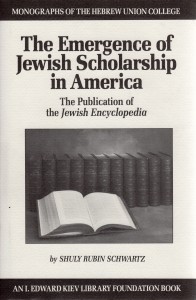 The Emergence of Jewish Scholarship in America: The Publication of the Jewish Encyclopedia
The Emergence of Jewish Scholarship in America: The Publication of the Jewish Encyclopedia
Shuly Rubin Schwartz
Throughout this fascinating study, Schwartz explores the complex and frequently strong relationships among Jewish leaders. Most importantly, she demonstrates that through its content as well as through the very fact of its publication in the United States and in English, the Jewish Encyclopedia signified the transfer of the center, language, and leadership of Jewish scholarship from the Old World to the New, thus becoming a primary catalyst for the emergence of Jewish scholarship in America.
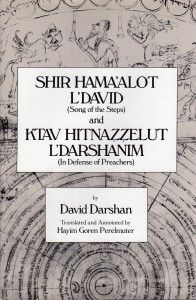 Shir haMa’alot l’David (Song of the Steps) and Ktav Hitnazzelut l’Darshanim (In Defense of Preachers)
Shir haMa’alot l’David (Song of the Steps) and Ktav Hitnazzelut l’Darshanim (In Defense of Preachers)
David Darshan, translated and annotated by Hayim Goren Perelmuter
David Darshan of Cracow was the first of the itinerant Jewish preachers whose works were published. He was a Renaissance man in a very real sense. Preacher, scholar, artist, healer, scribe, mystic, editor, commentator, and bibliophile (and father of five daughters), he tried in vain to establish an academy but failed because he was on the wrong side of the establishment. This account of his background and translation of two almost forgotten books, Shir haMa’a lot l’David and Ktav Hitnazzelut l’Darshanim lifts the curtain on the inner life of the Jewish world in the late Middle Ages.
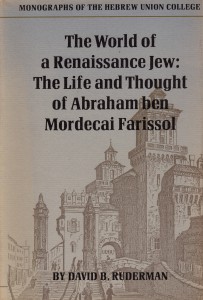 The World of a Renaissance Jew: The Life and Thought of Abraham ben Mordecai Farissol
The World of a Renaissance Jew: The Life and Thought of Abraham ben Mordecai Farissol
David B. Ruderman
Within the Italian city states of the fifteenth and sixteenth centuries, a relatively high degree of mutual tolerance and tranquility existed between the enlightened Christian majority and the small Jewish minority. With the prevalence of favorable political, social, and economic circumstances for Jewish life in Italy, a considerable number of Jews participated freely in Renaissance culture while upholding an intense awareness of their own particular identity. This work is a study of the life and thought of one such Jew, Abraham b. Mordecai Farissol (1452-ca. 1528).
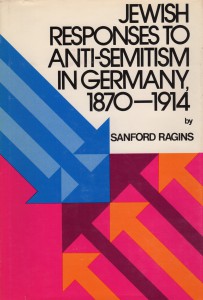 Jewish Responses to Anti-Semitism in Germany, 1870-1914: A Study in the History of Ideas
Jewish Responses to Anti-Semitism in Germany, 1870-1914: A Study in the History of Ideas
Sanford Ragins
Dr. Ragins’ study is an attempt to understand how the German Jewish community responded to anti-Semitism during the decades before World War I, and, especially, why it reacted as it did. The central argument of the book is that German Jewry defended itself against modern anti-Semitism with all the ideological, legal, and organizational weapons at its disposal, and that the liberal Jews of Germany mounted the best possible defenses which could be achieved in their historical circumstances.
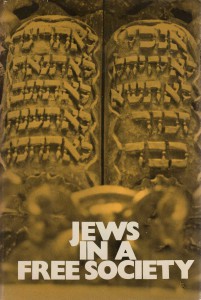 Jews in a Free Society: Challenges and Opportunities
Jews in a Free Society: Challenges and Opportunities
Edited by Edward A. Goldman
This volume contains the lectures which the faculty of the Cincinnati School of Hebrew Union College-Jewish Institute of Religion presented to the larger community during the College Centennial Year. They are lectures by scholars moving out of the strict confines of their specialty and addressing a lay audience at large, spreading Jewish information filtered through the channels of Jewish learning and representing a discussion of contemporary problems and concerns in the light of scholarly findings.
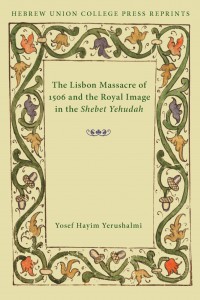 The Lisbon Massacre of 1506 and the Royal Image in the Shebet Yehudah
The Lisbon Massacre of 1506 and the Royal Image in the Shebet Yehudah
Yosef Hayim Yerushalmi
In this landmark study, Yosef Hayim Yerushalmi presents the Lisbon Massacre as one chapter in the history of alliances between Jews and the powers that have ruled over them. Through an exploration of Jewish attitudes and their consequences at this important juncture in Jewish history, he uncovers the “myth of the royal alliance” in the thought of Ibn Verga and others. He offers a fresh review of available data on the course of the pogrom and relates it to the Shebet Yehudah.
 Reform Judaism: Essays by Hebrew Union College Alumni
Reform Judaism: Essays by Hebrew Union College Alumni
Edited by Bernard J. Bamberger
The volume, which honors the vision of Isaac Mayer Wise, includes essays from Levi A. Olan, Joshua Loth Liebman, Solomon B. Freehof, Beryl D. Cohon, Morris Lieberman, Nathan Perilman, Leon Fram, David H. Wice, Abraham J. Feldman, Jacob D. Schwarz, Emil Leipziger, and Max Reichler, as well as an introduction by Bernard J. Bamberger.


